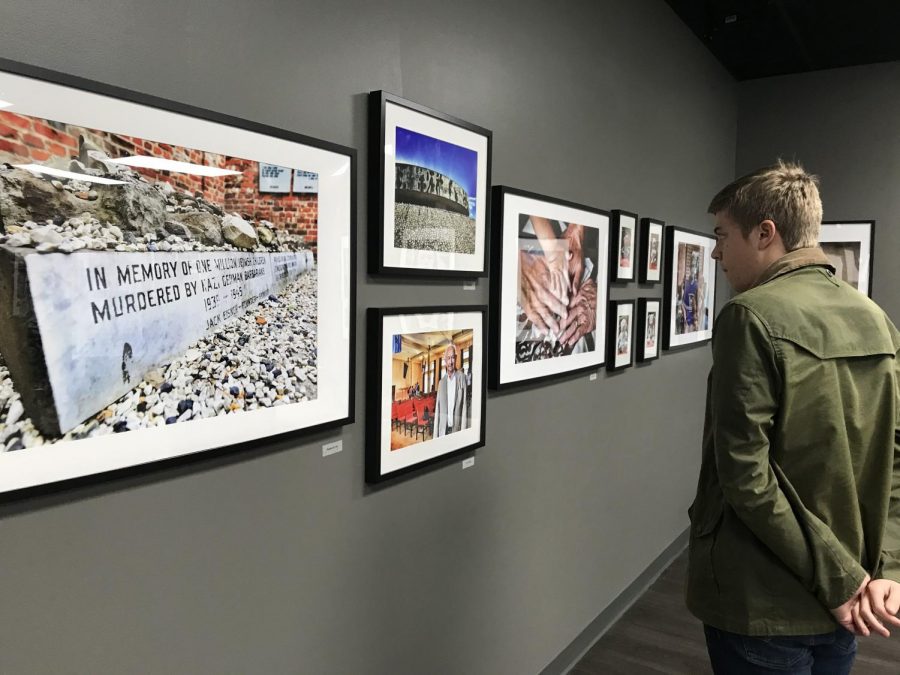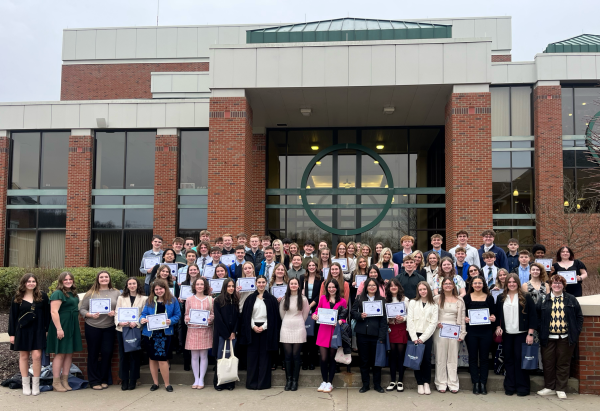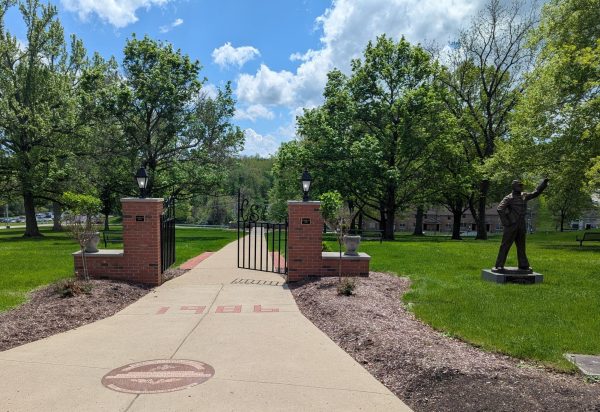Trinity students impacted by trip to Holocaust Center
Senior Jonathan Brodak takes time to appreciate some of the photographs in the “Roots” exhibit at the Holocaust Center in Pittsburgh.
Around 1933, approximately 500,000 of the 67 million people living in Germany were Jewish, making up less than one percent of the German population. On November 7, 2019, 37 Trinity High School students traveled to the Holocause Center of Pittsburgh and were astounded to learn that this small portion of the German population were seen as so much of a threat to Adolf Hitler that he began one of the most atrocious genocides in the history of the world.
Ms. Shaw, Mrs. Macino and Mrs. Berty served as the three teacher chaperones, and most of the students who attended were from Ms. Shaw’s Honors English 10 class. Students toured the Holocaust Center and learned about artfifacts from the Holocaust, such as uniforms, newspapers and propoganda.
Shaw explained that she wants students to go on this trip because “one of my goals of my daily teaching is to promote tolerance, empathy and compassion, and learning about other cultures helps to instill those traits in my students.”
While at the Holocaust Center, students listened to the true story of Ilsa Dahl, a young woman who fled Germany following Kristallnacht, or “Night of Broken Glass,” as told by her granddaughter, Emily Loeb. Dahl lived in the small German town of Geilenkirchen for nearly her entire life, and although Dahl was Jewish, she still attended a Catholic school and was treated no differently than anyone else. That all changed when the Nazi regime took control of Germany in 1933.
The German Nazi party built their Fascist belief on hatred of Jews and people they saw as “nonessential.” This persecution was not a sudden event; it was a slow and humiliating process that separated “us” from “them” more and more as time went on.
Dahl remembered how people who were her friends her entire life suddenly refused to talk to Dahl or feared her, and how she became an outcast from her school friends and people who knew Dahl her entire life. Yet, Dahl stayed in Geilenkirchen because Germany was her home and had been her family’s home for 220 years.
It wasn’t until November 9, 1938, during Kristallnacht, that Dahl realized she was no longer welcomed in Germany. While she was staying with her great-grandparents, a German soldier proclaimed that because they were Jewish, they “had ten minutes” before the German military would burn down their house. Dahl knew she had to escape. In 1938, Dahl and her husband escaped to America through Belgium.
When learning about history, students can find it difficult to relate to past events. Yet, experiences such as the trip to the Holocaust Center helps to connect people with the past and understand what it would’ve been like to live during that time period. Hearing a story like Dahl’s and learning she lived a normal life up to the point of the Nazi takeover makes history feel not only real, but also more frightening because it allows the students to see that people have the capacity to perform such horrific acts against each other.
Junior Peyton Celani, a student who attended the trip, said “the Holocaust Center excels at creating awareness. These topics are not easy topics to discuss, and the Holocaust Center does a really good job at explaining what and why these events happened.”
In addition to listening to the presentation by Loeb, students toured a photography exhibit called “OpticVoices: Roots.” “Roots” is an exhibit created by Emmy Award-winning filmmaker Emmai Alaquiva in hopes to highlight the healing process after losing a loved one, especially after the Tree of Life Synagogue shooting last year.
There were many photographs in the exhibit, but one of the most poignant was titled “Wilted Flower,” which was taken in Auschwitz, Poland. The picture showed what appeared to be small buildings and a small garden in the background. In the foreground, a wilted flower is tied into a knot on a barbed wire fence. This photograph highlights how a person can ignore what is occuring, just like how the observer can ignore the barbed wire and focus on the buildings and garden in the background. Yet, as hard as the observer may try, there is always something that can’t and shouldn’t be ignored: the wilted flower.
Why do students study these horrific events and stories? These stories exhibit issues which many cultures still deal with to this day. The Nazis were able to take over Germany by using an “us” vs “them” campaign, and the United States still has instances where people have an “us” vs “them” mentality. These exhibits helped students to understand how a separatist thought process can lead to tyranny and suffering, but also how students can recognize when something is wrong and can work to fix it.
They say obsessing over the past is an unhealthy habit, and Jonathan Brodak is here to confirm that myth! When Jonathan was a young lad, he enjoyed looking...






